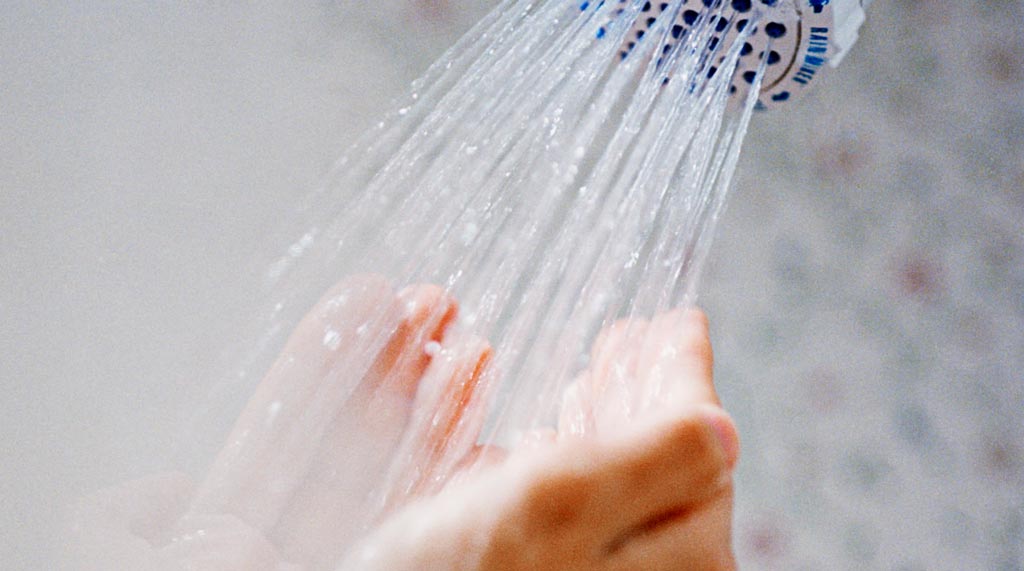Damaging Skin
Along with chlorine, there are a number of chemicals in the tap water that can cause visible damage to hair and skin, as well as invisible damage to the entire body system, including putting people at a higher risk of cancer. These chemicals include chlorine, chloroform, DCA (dichloroacetic acid), and MX (a chlorinated acid).
Chlorine hardens arteries, destroys proteins, irritates the skin, and aggravates sinus infections and all respiratory problems. Chloroform, DCA, and MX are all by-products of chlorine and can cause excessive cell mutation, which could lead to cancer.
Research indicates that there is an increased risk of bladder and rectal cancer in people who drink chlorinated water. However, tests show that by taking a 10-minute shower a person is absorbing as much chlorine as he or she would by drinking eight glasses of water.
This is because a warm shower opens up the pores, causing each person who showers to absorb the chlorine through the skin while inhaling it from the shower steam as well.
The only solution to this problem is to install a showerhead that filters water from chlorine, as chlorine is a required ingredient in all public water supply systems.
In fact, Dr. Lance Wallace from the US Environmental Protection Agency (EPA) states, “Showering is suspected as the primary cause of elevated levels of chloroform in nearly every home, because of chlorine in the water.”

Releasing the Molds
Since chlorine was introduced into the water system as a standard in 1904 in the UK, cases of childhood asthma have increased by 300 percent, and cancers have been on the rise.
According to the US Council of Environmental Quality (CEQ), cancer risk among people drinking chlorinated water is 93 percent higher than among those whose water does not contain chlorine.
Another study carried out in Hartford, Connecticut, found that “women with breast cancer have 50 percent to 60 percent higher levels of organochlorines (chlorination by-products) in their breast tissue than women without breast cancer.”
However, once you remove the chlorine from your water, the risk of mold growth in your bathroom will increase. Molds in the bathroom are the third-largest health hazard associated with cleanliness.
Stay Healthy
To clean molds from your bathroom, you need to make sure that your bathroom is properly ventilated and not leaking.
Each time the bathroom is used, it should be aired out and kept as dry as possible. One should also be diligent about checking windowsills, rugs, and shower curtains that are famous for harboring mold colonies.
Once the problem of moisture is taken care of, mold that has already grown can be eradicated using tea tree oil, grapefruit seed extract (GSE), or simple vinegar.
Start by washing and scrubbing the area with baking soda or other cleansers. Be sure to use an abrasive sponge and wear a mask. Once your initial cleaning is finished, you should cover the entire area with a mold inhibitor. You can use straight vinegar in a spray bottle, or you can combine two teaspoons of tea tree oil or twenty drops of GSE with two cups of water and spray on all previously washed and scrubbed surfaces. Do not rinse. This will kill any remaining mold and will prevent additional mold from forming.
Exposure to mold can affect the health of many people. The most common effects are allergic responses, such as hay fever or asthma. Also irritation of the eyes, nose, throat, or lungs.
Other symptoms of mold exposure can include depression, nasal congestion, respiratory problems, headaches, and rashes. What can be more dangerous is that these reactions may not be immediately noticed and traced back to molds. One of the most common symptoms of mold exposure is pneumonitis, a disease that resembles bacterial pneumonia.
Reactions to molds can build up, causing the immune system to deteriorate or allergies to become more severe.
This article is from our archive, originally published on an earlier date, and now republished for its importance.
References:
- Bryner, Jeanna. “Showerheads May Be Spraying Out Bacteria.” MSNBC. 16 Sept. 2009. Accessed 21 Jan. 2010.
- Group, Dr. Edward F III “Chlorine, Cancer, and Heart Disease.” Global Healing Center. Accessed 21 Jan. 2010. 2009.
- Howard, Stan. “Chlorine in Your Shower Water.” Annie’s Appleseed Project.


